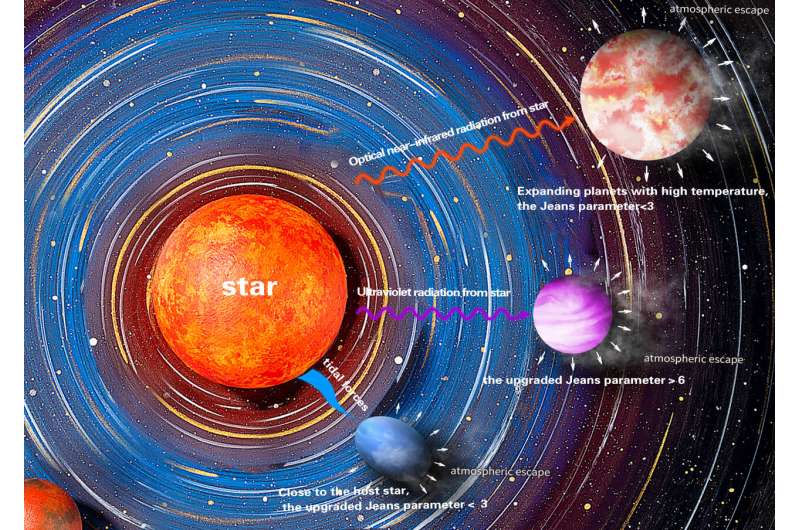Various driving mechanisms affecting hydrodynamic escape from low-mass exoplanets. Image source: Chinese Academy of Sciences/Guo Jianheng.
A study published in natural astronomy The study, led by Jianheng Guo of the Yunnan Observatory of the Chinese Academy of Sciences, provides insights into the violent atmospheric escape processes of low-mass exoplanets, specifically a process called hydrodynamic escape.
It reveals the various driving mechanisms affecting hydrodynamic escape and proposes a new classification method to understand these escape processes.
Exoplanets refer to planets outside the solar system and are a popular topic in astronomical research. The atmospheres of these planets can leave the planet and enter space for various reasons. One reason is hydrodynamic escape, which is the process by which the upper atmosphere leaves the entire planet. This process is much more intense than the particle escape behavior observed in solar system planets.
Hydrodynamic atmospheric escape may have occurred in the early stages of the solar system’s planets. If the Earth had lost its entire atmosphere through hydrodynamic escape, it would have become as desolate as Mars. Now, such violent escapes no longer occur on planets like Earth. However, space and ground-based telescopes have observed that hydrodynamic escape still occurs on some exoplanets very close to their host stars. This process not only changes the planet’s mass, but also affects its climate and habitability.
In this study, Jianheng Guo found that hydrodynamic escape from low-mass exoplanets may be driven individually or jointly by the planet’s internal energy, work done by the star’s tidal forces, or heating by the star’s extreme ultraviolet radiation.
Before this study, researchers had to rely on complex models to figure out which physical mechanisms drive fluid escape on planets, and the conclusions were often vague. This study proposes that hydrodynamic escape mechanisms of low-mass planets can be classified using only basic physical parameters of stars and planets, such as mass, radius and orbital distance.
On a planet with a small mass and a large radius, sufficient internal energy or high temperature can drive the atmosphere to escape. This study shows that it is possible to determine whether the escape described above occurs using the classical Jeans parameter (the ratio of a planet’s internal energy to its potential energy).
For planets whose internal energy cannot drive atmospheric escape, Guo Jianheng defined an upgraded version of the Jeans parameter by introducing the tidal force from the star. Through the upgraded Jeans parameters, the roles of stellar tidal forces and extreme ultraviolet radiation in driving atmospheric escape can be easily and accurately distinguished.
Additionally, this study shows that planets with high gravitational potential energy and low stellar radiation are more likely to experience slow hydrodynamic atmospheric escape; otherwise, Earth would primarily experience fast liquid escape.
The results of this study shed light on how a planet’s atmosphere evolves over time, which is important for exploring the evolution and origins of low-mass planets and helping to better understand the habitability and evolutionary history of these distant worlds.
More information:
JH Guo, Characterization of hydrodynamic escape regimes of low-mass exoplanets, natural astronomy (2024). DOI: 10.1038/s41550-024-02269-w
Provided by Chinese Academy of Sciences
citation: Study reveals hydrodynamic escape mechanisms for low-mass exoplanets (2024, May 10), Retrieved May 10, 2024, from https://phys.org/news/2024-05-reveals-mechanisms -Hydrdynamic-mass-exoplanets.html
This document is protected by copyright. No part may be reproduced without written permission except in the interests of fair dealing for private study or research purposes. Content is for reference only.
#Study #reveals #hydrodynamic #escape #mechanism #lowmass #exoplanets
Image Source : phys.org
